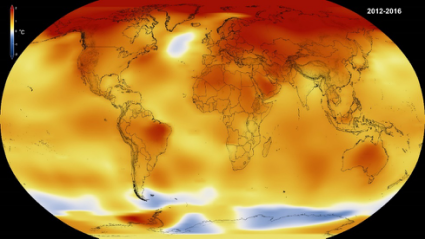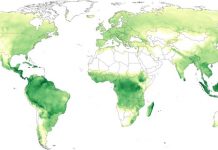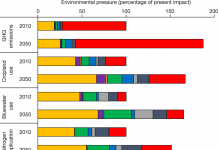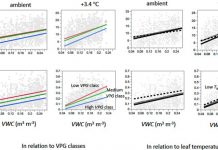【南京冰川环境下活性有机碳的微生物形成】H. J. Smith, R. A. Foster, D. M. McKnight, J. T. Lisle, S. Littmann, M. M. M. Kuypers & C. M. Foreman. Microbial formation of labile organic carbon in Antarctic glacial environments. Nature Geoscience 10, 356–359 (2017) doi:10.1038/ngeo2925
Abstract
Roughly six petagrams of organic carbon are stored within ice worldwide. This organic carbon is thought to be of old age and highly bioavailable. Along with storage of ancient and new atmospherically deposited organic carbon, microorganisms may contribute substantially to the glacial organic carbon pool. Models of glacial microbial carbon cycling vary from net respiration to net carbon fixation. Supraglacial streams have not been considered in models although they are amongst the largest ecosystems on most glaciers and are inhabited by diverse microbial communities. Here we investigate the biogeochemical sequence of organic carbon production and uptake in an Antarctic supraglacial stream in the McMurdo Dry Valleys using nanometre-scale secondary ion mass spectrometry, fluorescence spectroscopy, stable isotope analysis and incubation experiments. We find that heterotrophic production relies on highly labile organic carbon freshly derived from photosynthetic bacteria rather than legacy organic carbon. Exudates from primary production were utilized by heterotrophs within 24 h, and supported bacterial growth demands. The tight coupling of microbially released organic carbon and rapid uptake by heterotrophs suggests a dynamic local carbon cycle. Moreover, as temperatures increase there is the potential for positive feedback between glacial melt and microbial transformations of organic carbon.
【人为侵蚀抵消源自土地覆盖变化碳排放的三分之一】Zhengang Wang, Thomas Hoffmann, Johan Six, Jed O. Kaplan, Gerard Govers, Sebastian Doetterl & Kristof Van Oost. Human-induced erosion has offset one-third of carbon emissions from land cover change. Nature Climate Change 7, 345–349 (2017) doi:10.1038/nclimate3263
Abstract
Anthropogenic land cover change (ALCC) is an important carbon (C) loss mechanism1, 2, 3, but current methods do not consider the role of accelerated soil organic C erosion and its burial in sediments in their assessments of net soil–atmosphere C exchange. Using a comprehensive global database and parsimonious modelling, we evaluate the impact of anthropogenic soil erosion on C fluxes between the Earth’s surface and atmosphere from the onset of agriculture to the present day. We find that agricultural erosion represents a very large and transient perturbation to the C cycle and has induced a cumulative net uptake of 78 ± 22 Pg C in terrestrial ecosystems during the period 6000 BC to AD 2015. This erosion-induced soil organic C sink is estimated to have offset 37 ± 10% of previously recognized C emissions resulting from ALCC. We estimate that rates of C burial have increased by a factor of 4.6 since AD 1850. Thus, current assessments may significantly overestimate both past and future anthropogenic emissions from the land. Given that ALCC is the most uncertain component of the global C budget and that there is a strong connection between ALCC and erosion, an explicit representation of erosion and burial processes is essential to fully understand the impact of human activities on the net soil–atmosphere C exchange.
【气候变暖对北半球高纬度地区生态系统春季碳汇的促进作用正在减弱】Shilong Piao, Zhuo Liu, Tao Wang, Shushi Peng, Philippe Ciais, Mengtian Huang, Anders Ahlstrom, John F. Burkhart, Frédéric Chevallier, Ivan A. Janssens, Su-Jong Jeong, Xin Lin, Jiafu Mao, John Miller, Anwar Mohammat, Ranga B. Myneni, Josep Peñuelas, Xiaoying Shi, Andreas Stohl, Yitong Yao, Zaichun Zhu & Pieter P. Tans. Weakening temperature control on the interannual variations of spring carbon uptake across northern lands. Nature Climate Change 7, 359–363 (2017) doi:10.1038/nclimate3277
Abstract
Ongoing spring warming allows the growing season to begin earlier, enhancing carbon uptake in northern ecosystems1, 2, 3. Here we use 34 years of atmospheric CO2 concentration measurements at Barrow, Alaska (BRW, 71° N) to show that the interannual relationship between spring temperature and carbon uptake has recently shifted. We use two indicators: the spring zero-crossing date of atmospheric CO2 (SZC) and the magnitude of CO2 drawdown between May and June (SCC). The previously reported strong correlation between SZC, SCC and spring land temperature (ST) was found in the first 17 years of measurements, but disappeared in the last 17 years. As a result, the sensitivity of both SZC and SCC to warming decreased. Simulations with an atmospheric transport model4 coupled to a terrestrial ecosystem model5 suggest that the weakened interannual correlation of SZC and SCC with ST in the last 17 years is attributable to the declining temperature response of spring net primary productivity (NPP) rather than to changes in heterotrophic respiration or in atmospheric transport patterns. Reduced chilling during dormancy and emerging light limitation are possible mechanisms that may have contributed to the loss of NPP response to ST. Our results thus challenge the ‘warmer spring–bigger sink’ mechanism.
Zhe (Han) Weng, Lukas Van Zwieten, Bhupinder Pal Singh, Ehsan Tavakkoli, Stephen Joseph, Lynne M. Macdonald, Terry J. Rose, Michael T. Rose, Stephen W. L. Kimber, Stephen Morris, Daniel Cozzolino, Joyce R. Araujo, Braulio S. Archanjo & Annette Cowie. Biochar built soil carbon over a decade by stabilizing rhizodeposits. Nature Climate Change 7, 371–376 (2017) doi:10.1038/nclimate3276
Abstract
Biochar can increase the stable C content of soil. However, studies on the longer-term role of plant–soil–biochar interactions and the consequent changes to native soil organic carbon (SOC) are lacking. Periodic 13CO2 pulse labelling of ryegrass was used to monitor belowground C allocation, SOC priming, and stabilization of root-derived C for a 15-month period—commencing 8.2 years after biochar (Eucalyptus saligna, 550 °C) was amended into a subtropical ferralsol. We found that field-aged biochar enhanced the belowground recovery of new root-derived C (13C) by 20%, and facilitated negative rhizosphere priming (it slowed SOC mineralization by 5.5%, that is, 46 g CO2-C m−2 yr−1). Retention of root-derived 13C in the stable organo-mineral fraction (<53 μm) was also increased (6%, P < 0.05). Through synchrotron-based spectroscopic analysis of bulk soil, field-aged biochar and microaggregates (<250 μm), we demonstrate that biochar accelerates the formation of microaggregates via organo-mineral interactions, resulting in the stabilization and accumulation of SOC in a rhodic ferralsol.








